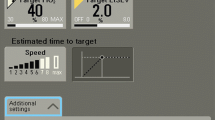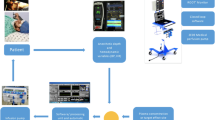Abstract
The ability to monitor the inspired and expired concentrations of volatile anesthetic gases in real time makes these drugs implicitly targetable. However, the end-tidal concentration only represents the concentration within the brain and the vessel rich group (VRG) at steady state, and very poorly approximates the VRG concentration during common dynamic situations such as initial uptake and emergence. How should the vaporization of anesthetic gases be controlled in order to optimally target VRG concentration in clinical practice? Using a generally accepted pharmacokinetic model of uptake and redistribution, a transfer function from the vaporizer setting to the VRG is established and transformed to the time domain. Targeted actuation of the vaporizer in a time-optimal manner is produced by a variable structure, sliding mode controller. Direct mathematical application of the controller produces rapid cycling at the limits of the vaporizer, further prolonged by low fresh gas flows. This phenomenon, known as “chattering”, is unsuitable for operating real equipment. Using a simple and clinically intuitive modification to the targeting algorithm, a variable low-pass boundary layer is applied to the actuation, smoothing discontinuities in the control law and practically eliminating chatter without prolonging the time taken to reach the VRG target concentration by any clinically significant degree. A model is derived for optimum VRG-targeted control of anesthetic vaporizers. An alternate and further application is described, in which deliberate perturbation of the vaporization permits non-invasive estimation of parameters such as cardiac output that are otherwise difficult to measure intra-operatively.





Similar content being viewed by others
References
Gupta DK, Eger EI. Inhaled anesthesia: the original closed-loop drug administration paradigm. Clin Pharmacol Ther. 2008;84(1):15–8.
Eger EI, Saidman LJ, Brandstater B. Minimum alveolar anesthetic concentration: a standard of anesthetic potency. Anesthesiology. 1965;26(6):756–63.
Sieber TJ, Frei CW, Derighetti M, Feigenwinter P, Leibundgut D, Zbinden AM. Model-based automatic feedback control versus human control of end-tidal isoflurane concentration using low-flow anaesthesia. Br J Anaesth. 2000;85(6):818–25.
Lortat-Jacob B, Billard V, Buschke W, Servin F. Assessing the clinical or pharmaco-economical benefit of target controlled desflurane delivery in surgical patients using the Zeus anaesthesia machine. Anaesthesia. 2009;64(11):1229–35.
Shafer SL, Siegel LC, Cooke JE, Scott JC. Testing computer-controlled infusion pumps by simulation. Anesthesiology. 1988;68(2):261–6.
Bailey JM, Shafer SL. A simple analytical solution to the three-compartment pharmacokinetic model suitable for computer-controlled infusion pumps. IEEE Trans Biomed Eng. 1991;38(6):522–5.
Shafer SL, Gregg KM. Algorithms to rapidly achieve and maintain stable drug concentrations at the site of drug effect with a computer-controlled infusion pump. J Pharmacokinet Biopharm. 1992;20(2):147–69.
Zwart A, Seagrave RC, Van Dieren A. Ventilation-perfusion ratio obtained by a noninvasive frequency response technique. J Appl Physiol. 1976;41(3):419–24.
Ascher UM, Petzold LR. Computer methods for ordinary differential equations and differential-algebraic equations. Philadelphia: Society for Industrial and Applied Mathematics; 1998.
Yasuda N, Targ AG, Eger EI. Solubility of I-653, sevoflurane, isoflurane, and halothane in human tissues. Anesth Analg. 1989;69(3):370–3.
Heffernan PB, Gibbs JM, McKinnon AE. Teaching the uptake and distribution of halothane. A computer simulation program. Anaesthesia. 1982;37(1):9–17.
Garfield JM, Paskin S, Philip JH. An evaluation of the effectiveness of a computer simulation of anaesthetic uptake and distribution as a teaching tool. Med Educ. 1989;23(5):457–62.
Kennedy RR, French RA, Gilles S. The effect of a model-based predictive display on the control of end-tidal sevoflurane concentrations during low-flow anesthesia. Anesth Analg. 2004;99(4):1159–63.
Kuo AS, Vijjeswarapu MA, Philip JH. Incomplete spontaneous recovery from airway obstruction during inhaled anesthesia induction: a computational simulation. Anesth Analg. 2016;122(3):698–705.
Stroud KA. Laplace transforms: programmes and problems. New York: Wiley; 1973. ISBN 0470834153.
Jenkins M, Traub JF. A three-stage algorithm for real polynomials using quadratic iteration. SIAM J Num Anal. 1970;7(4):545–66.
Garcia CE, Prett DM, Morari M. Model predictive control: theory and practice—a survey. Automatica. 1989;25(3):335–48.
DeCarlo RAZ, Drakunov SH, S.V. Variable Structure, Sliding-Mode Controller Design. In: Levine WS, The Control Handbook. New York, NY: IEEE Press; 1996.
Sonneborn L, Van Vleck F. The bang-bang principle for linear control systems. J Soc Ind Appl Math A. 1964;2(2):151–9.
Hung JY, Gao W, Hung JC. Variable structure control: a survey. IEEE Trans Industr Electron. 1993;40(1):2–22.
Tseng ML, Chen MS. Chattering reduction of sliding mode control by low-pass filtering the control signal. Asian Journal of Control. 2010;12(3):392–8.
Draper NR, Smith H. Applied regression analysis. Wiley series in probability and mathematical statistics. 2d ed. New York: Wiley; 1981.
Chatterjee S, Hadi AS. (1986) Influential observations, high leverage points, and outliers in linear regression. Stat Sci. 1:379–93.
Struys MM, Kalmar AF, De Baerdemaeker LE, Mortier EP, Rolly G, Manigel J, Buschke W. Time course of inhaled anaesthetic drug delivery using a new multifunctional closed-circuit anaesthesia ventilator. In vitro comparison with a classical anaesthesia machine. Br J Anaesth. 2005;94(3):306–17.
Bottom DK. (2013) Medical vaporizer and method of control of a medical vaporizer. US Patent and Trademark Office, US8752544.
Van Poucke GE, Bravo LJ, Shafer SL. Target controlled infusions: targeting the effect site while limiting peak plasma concentration. IEEE Trans Biomed Eng. 2004;51(11):1869–75.
Kang C-G. Origin of Stability Analysis: “On Governors” by JC Maxwell. IEEE Control Systems. 2016;36(5):77–88.
Standards for Basic Anesthetic Monitoring. Committee of Origin: Standards and Practice Parameters (2016). Approved by the ASA House of Delegates on October 21, 1986, last amended on October 20, 2010, and last affirmed on October 28, 2016. edn. American Society of Anesthesiologists, http://www.asahq.org/~/media/Sites/ASAHQ/Files/Public/Resources/standards-guidelines/standards-for-basic-anesthetic-monitoring.pdf.
Sangkum L, Liu GL, Yu L, Yan H, Kaye AD, Liu H. Minimally invasive or noninvasive cardiac output measurement: an update. J Anesth. 2016;30(3):461–80.
Thiele RH, Bartels K, Gan TJ. Cardiac output monitoring: a contemporary assessment and review. Crit Care Med. 2015;43(1):177–85.
Drummond KE, Murphy E. Minimally invasive cardiac output monitors. Cont Educ Anaesth Crit Care Pain. 2011;12(1):5–10.
Funk DJ, Moretti EW, Gan TJ. Minimally invasive cardiac output monitoring in the perioperative setting. Anesth Analg. 2009;108(3):887–97.
Klein M, Minkovich L, Machina M, Selzner M, Spetzler VN, Knaak JM, Roy D, Duffin J, Fisher JA. Non-invasive measurement of cardiac output using an iterative, respiration-based method. Br J Anaesth. 2015;114(3):406–13.
Agostoni P, Cattadori G. Noninvasive cardiac output measurement: a new tool in heart failure. Cardiology. 2009;114(4):244–6.
Wiegand G, Kerst G, Baden W, Hofbeck M. Noninvasive cardiac output determination for children by the inert gas-rebreathing method. Pediatr Cardiol. 2010;31(8):1214–8.
Bogaard HJ, Wagner PD. Measurement of cardiac output by open-circuit acetylene uptake: a computer model to quantify error caused by ventilation-perfusion inequality. Physiol Meas. 2006;27(10):1023–32.
Kalman RE. A new approach to linear filtering and prediction problems. J Basic Eng. 1960;82(1):35–45.
Akman G, Kaufman H, Roy R. Continuous pulmonary capillary blood flow estimation from measurements of respiratory anesthetic gas concentration. IEEE Trans Bio-Med Eng. 1985;32(12):1017–31.
Hendrickx JF, De Cooman S, Deloof T, Vandeput D, Coddens J, De Wolf AM. The ADU vaporizing unit: a new vaporizer. Anesth Analg. 2001;93(2):391–5.
Young J, Kapoor V. Principles of anaesthetic vaporizers. Anaesth Intens Care Med. 2013;14(3):99–102.
Funding
Funidng was provide by National Institute of General Medical Sciences (Grant No. NIH R01 GM121457-01A1), and also Departmental support.
Author information
Authors and Affiliations
Contributions
The manuscript is the sole work of the Corresponding Author.
Corresponding author
Ethics declarations
Conflict of interest
Author declares that they have no conflict of interest.
Appendix: Source code for analytical solutions
Appendix: Source code for analytical solutions
The following matlab code (The MathWorks, Chestnut Hill, MA) performs the key analytical steps described in this paper.

Rights and permissions
About this article
Cite this article
Connor, C.W. Optimizing target control of the vessel rich group with volatile anesthetics. J Clin Monit Comput 33, 445–454 (2019). https://doi.org/10.1007/s10877-018-0169-5
Received:
Accepted:
Published:
Issue Date:
DOI: https://doi.org/10.1007/s10877-018-0169-5




